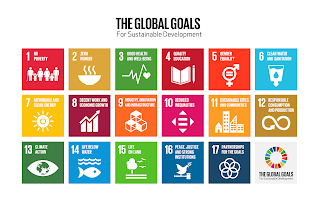PENCINTA ALAM JANUARY 2021
GREEN LIVING COLUMN:
SUSTAINABLE DEVELOPMENT GOAL (SDG) 12: RESPONSIBLE CONSUMPTION AND
PRODUCTION.
In December 2020, Green Living Coordinator Ee Lynn was interviewed by
Ecocentric Transitions for their Science Film Festival – Goethe Institute SDG
Online Series for a special episode on Sustainable Development Goal (SDG) 12:
Responsible Consumption and Production.
You can view the video here:
https://www.facebook.com/ecocentrictransitions/videos/842294303211720
As the video is over 40 minutes in length, we have decided to provide
you with a summary in the form of the quick facts below:
1. 1.3
billion tonnes of food is wasted every year, yet almost 2 billion people go
hungry or undernourished. At the same time, 2 billion people globally are
categorized as overweight or obese.
2. The
production of food accounts for around 22%
of total greenhouse gas emissions, and this is largely from the
conversion of forests into farmland. Globally, agriculture accounts for 92% of
global freshwater use. 29% of the water used in agriculture is directly or
indirectly used for animal production.
3. Livestock
is the world’s largest user of land resources, with pasture and arable land
dedicated to the production of feed representing almost 80% of total
agricultural land. One third of global arable land is used to grow feed, while
26% of the Earth’s ice-free terrestrial surface is used for grazing.
4. If
we continue to consume and waste resources the way we do, by the year 2050, we
will need the equivalent of 3 planet earths to sustain our lifestyles.
5. World
or Earth Overshoot Day is the calculated calendar date on which humanity’s
resource consumption for that year exceeds the Earth’s capacity to regenerate
those resources that year. It’s like taking out a bank overdraft that you know
you’re not going to be able to pay back.
6. The
way you calculate Earth Overshoot Day is by dividing the planet’s biocapacity
(which is the amount of natural resources generated by Earth that year) by the
world ecological footprint (which is humanity’s consumption of Earth’s natural
resources for that year) and multiplying it by 365.
7. Ecological
overshoot started in the early 1970s and is getting earlier each year. Earth
Overshoot Day 2019 fell on the 29th of July, the earliest ever. However,
due to the Covid19 pandemic, Earth Overshoot Day 2020 was pushed back to the 22nd
of August. This is mostly because of reduced fossil fuel consumption, people
were flying and driving less, and many factories and plants had to temporarily
shut down. There was also a 8.4% reduction in deforestation and the harvesting
of forest products because of movement restrictions worldwide and also because
of lower demand, which is good for the forests. The pandemic made us aware that
we can and should consume less, and we can do so without significantly reducing
the quality of our lives.
8. We
need food to survive, but the food we choose makes a big difference to our carbon
footprint. Food accounts for between 10 to 30 % of a household’s carbon
footprint. Food production accounts for 68% of food’s carbon emissions, while
transportation accounts for 5% of it. Since transportation accounts for only 5%
of the carbon footprint of our food, we should focus more on WHAT we eat, not
whether or not our food is locally produced and sourced.
9. Meat
production has a larger carbon footprint per calorie than plant-based food,
because of the inefficient transformation of plant energy to animal energy, and
due to the methane released from manure management and enteric fermentation in
livestock. It’s not efficient because its production is responsible for 60% of agriculture’s
greenhouse gas emissions, but meat products provide merely 18% of calories and
37% of protein levels around the world.
10. 70%
of the deforestation of the Amazon is to provide land for cattle ranches so if
you want to do something to protect the Amazon rainforest, one of the best
things you can do would be to go vegan if you can, go vegetarian if you can’t
go vegan, and reduce meat and dairy consumption as much as possible if you
can’t go fully vegetarian either. A regular meat-eater has the highest carbon
footprint at 3.3 tons of greenhouse gas emissions. A vegan diet has the lowest
carbon footprint at only 1.5 tons. You can reduce the carbon footprint of your
food by up to 73% just by cutting out meat and dairy.
11. Researchers
at the University of Oxford found that if everyone stopped eating meat and
dairy, global farmland use could be reduced by 75%. This is an area equivalent
to the size of the USA, China, Australia, and the European Union combined. Not
only would this significantly reduce greenhouse gas emissions, it would also
free up land which can then be rewilded to support wildlife populations again.
12. Cities
and towns need to be resilient in that in the event of a major disaster or
adverse event causing it to be cut off from other cities, it should be able to
produce sufficient food to meet the immediate needs of its residents. In
neighbouring Singapore, there are sky farming initiatives to boost the nation’s
food security by growing vegetables and fruits via hydroponics and aeroponics.
Singapore also has the distinction of becoming the first country to approve the
sale of lab-grown meat, and this will no doubt improve its food self
sufficiency because it will no longer have to rely as heavily on countries with
grazing land for animal protein. It would be great to see Malaysia take steps
towards increased food self sufficiency in each state and city, and promote the
replacement of conventionally grown meat with lab-grown meat and plant-based
meat, for environmental and health reasons, and also for food self-sufficiency.








